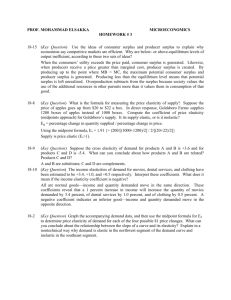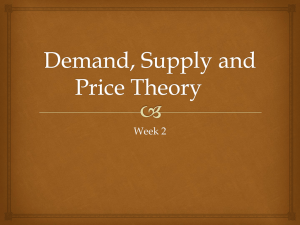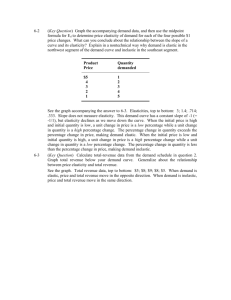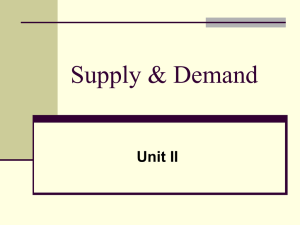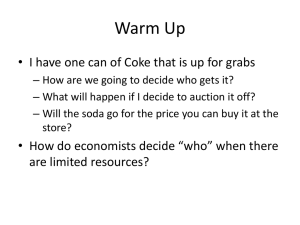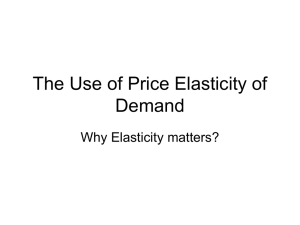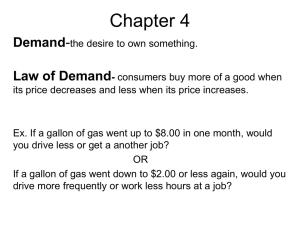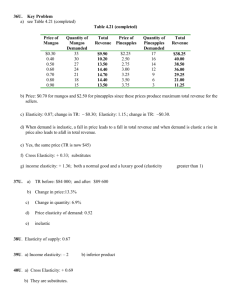highly price elastic
advertisement
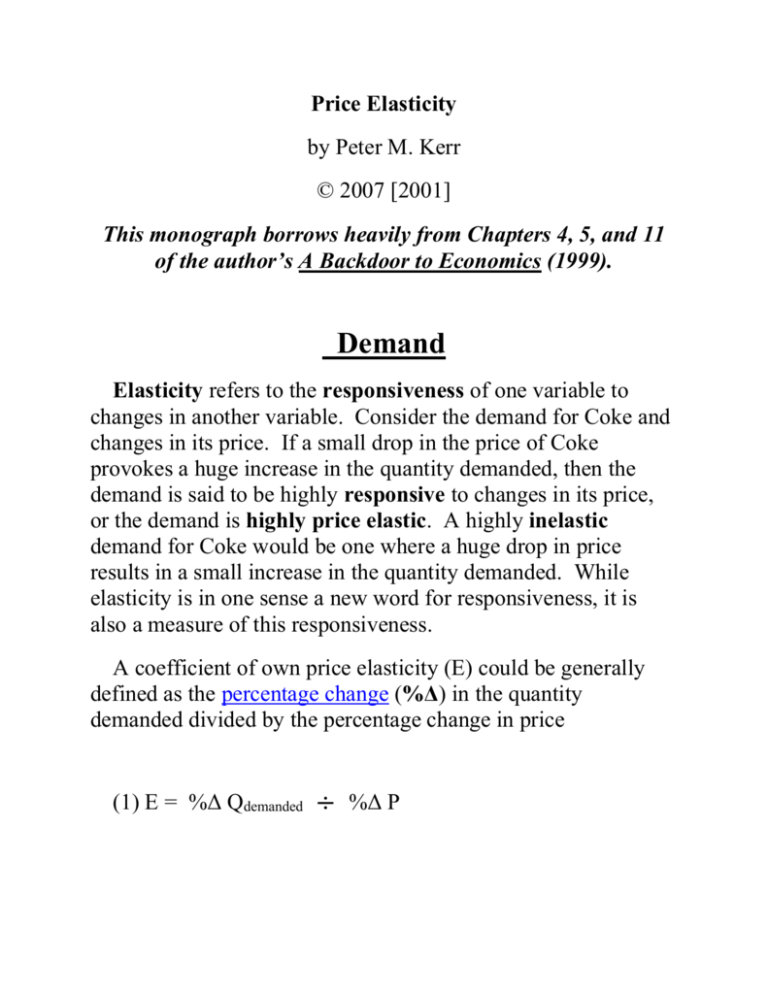
Price Elasticity by Peter M. Kerr © 2007 [2001] This monograph borrows heavily from Chapters 4, 5, and 11 of the author’s A Backdoor to Economics (1999). Demand Elasticity refers to the responsiveness of one variable to changes in another variable. Consider the demand for Coke and changes in its price. If a small drop in the price of Coke provokes a huge increase in the quantity demanded, then the demand is said to be highly responsive to changes in its price, or the demand is highly price elastic. A highly inelastic demand for Coke would be one where a huge drop in price results in a small increase in the quantity demanded. While elasticity is in one sense a new word for responsiveness, it is also a measure of this responsiveness. A coefficient of own price elasticity (E) could be generally defined as the percentage change (%Δ) in the quantity demanded divided by the percentage change in price (1) E = %Δ Qdemanded ÷ %Δ P While this general definition is excellent for interpreting a coefficient, for calculation purposes we must use the following variant of this definition. (2) Earc = │Δ Q / Σ Q │ ──────────── │Δ P / Σ P │ This formula prescribes the following steps: (i) Subtract the original value of the quantity from its new value. (ii) Add the original value of the quantity to its new value. (iii) Divide (i) by (ii). (iv) Subtract the original value of the price from its new value. (v) Add the original value of the price to its new value. (vi) Divide (iv) by (v). (vii) Divide (iii) by (vi). (viii) Erase the minus (-) sign, i.e., use the absolute value. To see how this formula might be used, consider an individual’s demand for Coke diagrammed in Figure 1. If the price drops from $.80 to $.60, the quantity demanded will increase from 4 to 8 cans per week. (i) 8 - 4 = 4 (ΔQ) (ii) 8 + 4 = 12 (ΣQ) (iii) 4 ÷ 12 = 1/3 (i ÷ ii) (iv) .6 - .8 = -.2 (ΔP) (v) .6 + .8 = 1.4 (ΣP) (vi) -.2 ÷ 1.4 = -1/7 (iv ÷ v) (vii) (1/3) ÷ (-1/7) = - 7/3 = -2.3 (iii ÷ vi) (viii) │-2.3│ = 2.3 = EA As a ratio of percentages, EA is a pure number, i.e., it has no unit of measure like dollars or cans. The fact that EA equals 2.3 can be interpreted as a "one percent drop in price will result in a 2.3 percent increase in quantity demanded." [Note that a 25 percent drop in price was matched with a 100 percent increase in quantity demanded. Using the general definition of the coefficient, (1) above, would yield E = 4.] Figure 1. Oftentimes, new students of economics make the mistake of assuming that slope (i.e., "rise over run") and elasticity are the same. Clearly they are not. The slope of the demand curve is 20 and it is the same for any segment or arc of the demand curve. If price goes down by a dime, the quantity demanded goes up by 2 cans. What is the coefficient of elasticity in a different region of the demand curve? In figure 2 suppose that price began at $.40 and dropped to $.20. The coefficient of elasticity would be .4. Whereas the slope of a straight line never varies, the elasticity of a straight-line demand curve depends upon the segment under consideration. Figure 2. In terms of magnitude only (aka, absolute value) EA is greater then EB. Consider segment A; when price drops from $.80 to $.60, this is a decrease of $.20 or 25 percent. In segment B, the same decrease of $.20 is a 50 percent decrease. While both segments have the same absolute drop in price, arc A has a smaller relative drop. At the same time, both segments have the same absolute increase in quantity demanded, i.e., 4. However, arc A has a larger relative increase, 100 percent compared to arc B's 33 2/3 percent. Comparing segment A to B, a relatively smaller drop in price nets a relatively larger increase in quantity demanded. Clearly, quantity demanded is more responsive to price changes in region A than B, i.e., demand is more elastic in region A than B. This, of course, is reflected in the measures of elasticity. The greater the coefficient's absolute value, the more elastic the demand. According to the coefficients, a one percent drop in price would result in a 2.3 percent increase in quantity demanded in arc A, but only a .4 percent increase in arc B. The absolute value or the magnitude of the coefficient of elasticity allows economists establish categories for different demands. If E > 1, then the demand is said to be elastic. If E < 1, then demand is said to be inelastic. If E = 1, then demand is said to be unit elastic. In the latter case, the percentage change in price is exactly matched by the percentage change in quantity demanded. Table 1 summarizes this classification. Table 1 Value of E ________ Relationship between %Δ Q and %Δ P ____________________ Type of Demand ____________ E<1 %Δ Q < %Δ P inelastic E=1 %Δ Q = %Δ P unit elastic E>1 %Δ Q > %Δ P elastic Applying these criteria to the demand curve in Figure 3, demand in arc A is elastic while demand in B is inelastic. The coefficient of elasticity for a price drop from $.80 to $.20 (section C in Figure 3) is 1 which means that demand over C is unit elastic. Elasticity's elusiveness stems from the fact that it is a relative concept. Figure 3. Respond to the following questions. 1. Suppose that a 20 percent drop in the price of bicycles resulted in a 10 percent increase in sales. In this case, the elasticity of demand for bicycles would be A. elastic. B. unit elastic. C. inelastic. D. indeterminate, not enough information has been given. 2. When the Lasky Shoe Store dropped the price of a canvas sneaker from $25 to $20, sales increased from 50 pairs to 70 pairs per week. The magnitude of the coefficient of elasticity is A. .66 2/3. B. 1.5. C. 2.0. D. .5.


